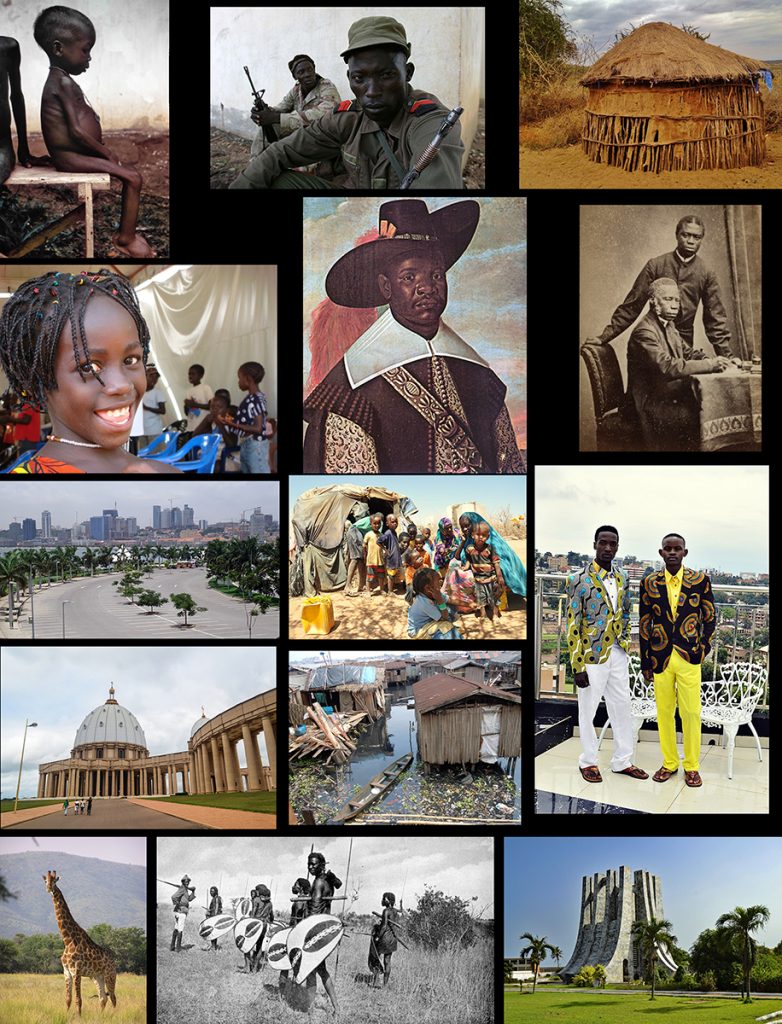Chapter 1: Orientation to Africa and its Art
Chapter 1.1: General Introduction

Africa. It’s a term that creates a neat box, limited by geographic boundaries. But what attributes does this continent’s name conjure? Your personal experience and exposure define your mental pictures of Africa. If you were raised there, your image is unlikely to be continent-wide. You picture the mango tree outside your house, your father and his friends sitting on mats and talking. Your mind is filled with images of city traffic and the cries of hawkers selling soft drinks, newspapers, tissues, plantain chips, peanuts. You’re transported to a boarding school as you press your uniform, hurrying to line up before the prefect discovers you’re late. If you aren’t African, and you’ve never travelled there, these particular scenes are unlikely to fill your mind. Your thoughts–positive or negative–are shaped by media, your education, and your imagination.
Despite American attempts to make K-12 education broader through multiculturalism, most elementary and high school teachers have studied little about Africa, and are as subject as their students to visual and cultural stereotypes. Why is it so easy to stereotype a whole continent? Partly because our sense of geography is weak. No American–even those who have never travelled–would assume that Icelandic and Greek cultures are identical or even substantially similar. Yet unfamiliarity with African countries and ethnonyms, histories, and cultural distinctions often groups anything from the continent with an adjective no more specific than “African.”
A quick look at a photo taken in space demonstrates just how small Europe is in comparison to Africa (Fig. 1). Print maps have distorted the size relationships of land masses for centuries in order to conveniently show longitude and latitude. A comparative map further indicates just how vast Africa is (Fig. 2). If we can recognize just how different Iceland and Greece are, then why are we so eager to believe that African cultures are similar, or assume that the continent shares a common religion, history, or arts?
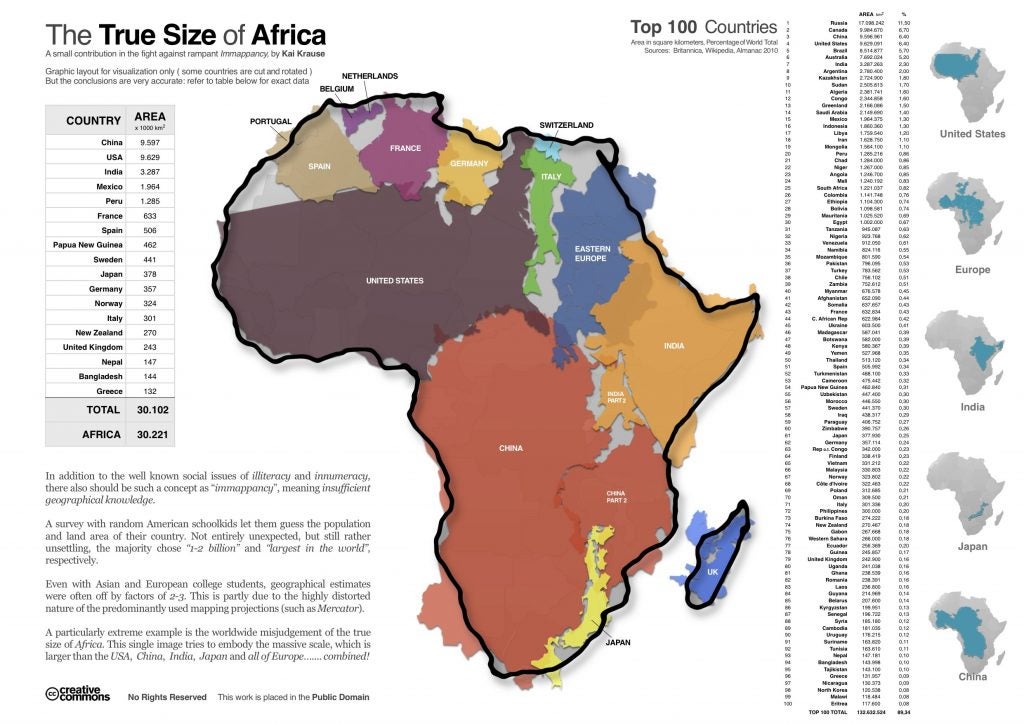
Media imagery has created a picture of Africa that is often out-of-date, exaggerated, or that magnifies issues of one area as if they apply to the continent. Often perspectives deny complexity or are ahistorical, as if Africa has remained unchanged for centuries or longer.
Many parts of Africa were in direct or indirect contact with Europe and Asia. Egypt and some other parts of North Africa were incorporated into the Roman Empire and afterward continued to trade with the Mediterranean world. By the 8th century, Arab-speaking chroniclers recorded information about parts of eastern, northern and western Africa. Ethiopians travelled to Byzantium and the Middle East, as well as India, and Persians and Arabs traded with a number of East African coastal communities, as did the Chinese (Fig. 3). The 15th century saw the beginning of European direct contact with West, then Central, then South and East Africa, as well as travelers’ accounts and documents written by Africans in European languages or Arabic.
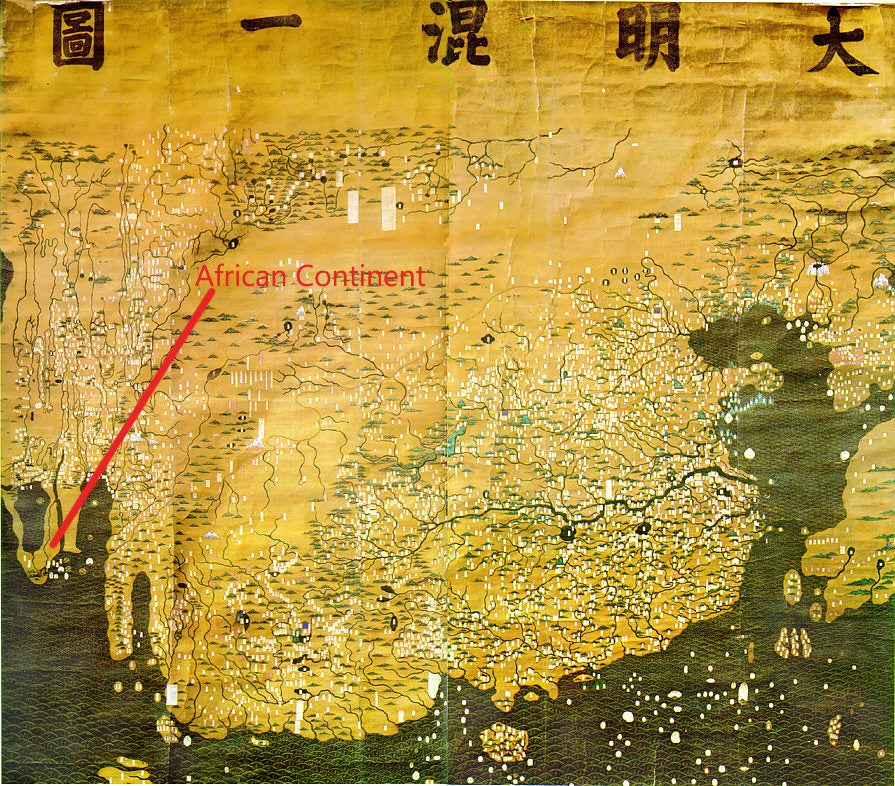
Because Europeans were confined primarily to coastal regions, their information about the West and Central African interiors was usually second-hand and often inaccurate. Access restriction until the 19th century prevented them from reaching the hinterland where they could obtain the raw materials they sought: gold, ivory, furs, pepper, and human beings. Coastal merchants, who acted as middlemen, profited from their control of trade. Europeans could not wrest it from them because they were few in number, arrived on floating targets, and were equipped with volatile gunpowder and inaccurate firearms whose reloading time was no match for a well-aimed arrow.
In the 19th century, however, all that changed. The repeating rifle shifted the military advantage, and, as the century wore on, the Maxim mounted machine gun provided even more effective firepower. Two additional shifts earlier in the century provided the military with advance intelligence: missionary and commercial penetration of the interior. Missionaries forged diplomatic alliances, took note of local power structures, and learned new languages. Commercial concerns such as the Royal Niger Company did the same.
While some European powers had gained an earlier foothold in Africa–the Portuguese in Angola and Mozambique, the Dutch at the Cape of Good Hope, the French at St. Louis along the Senegal River, and the turnover of Portuguese-Dutch-Danish-English occupants of coastal Ghanaian forts–the late 19th century produced European determination to carve up the continent into defined spheres of influence. The Berlin Conference of 1884-85 established European borders for French, English, Belgian, German, Portuguese, Italian, and Spanish interests that soon became colonies (Fig. 4).
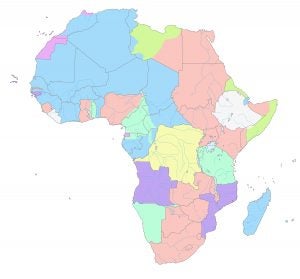
Colonialism did not actually last long. Most African nations became independent by 1960/61. In some respects, its impact was negligible; in others, it had major political and cultural effects. When Europeans took control, they found a continent with varied political systems. Some areas were empires or kingdoms, run by a single ruler and his counselors. Other areas were more egalitarian city-states, run by all adult men or by a gerontocracy. Some ethnic groups operated as single polities, while others comprised multiple states that warred with one another. The arbitrary nature of the Berlin Conference’s borders meant that old states or families might be split into two spheres. It also meant that former rulers might continue as cultural leaders if cooperative, or be dethroned or exiled if resistant. Even those who kept their positions no longer had military or full legal authority, nor did they have the ability to collect taxes. Governments based on the home country’s will were established, and independence did not reinstate traditional rulers to the full powers they had held previously.
Besides new political and court systems, foreign religious and educational systems had major lasting influences. Christianity arrived in Egypt, the Sudan, and Ethiopia in the 4th century, the same period it was recognized officially in Europe, and parts of northern and eastern Africa became Muslim immediately after the Prophet Muhammed’s death. Islam continued to spread into West Africa slowly via North African trade, but Christian missionization exploded in the 19th century, and since the 1970s both faiths have pushed many older religions aside. Advancement in the civil service–whether colonial or independence era–requires mastery of a foreign language that is usually the “language of instruction” in schools. Curricula are based on European models and extend to university level, which means they vary considerably depending on the former colonial power.
Access to international media and more accessible travel or migration have had their own impact. Foreign films, music videos, and clothing jostle with local products. While none of these features means that African culture has been abandoned, it does signify that values have been adjusted, and cultures often compete for supremacy, some winning because of their status as imported novelties. As we’ll see, the visual arts are part of this duality, with retentions of older practices coexisting with new materials, functions, training, and patrons.
There are many different ways of breaking this huge continent into smaller segments for effective discussion. We could look at climate zones: desert, Sahel, savannah, rainforest. We could consider colonial history and examine Anglophone, Francophone, or Lusophone nations. We’re going to take an approach that considers a limited number of geographic zones, dividing the continent into seven sectors. These often include areas that were once part of a large kingdom or kingdoms, or had linked trading patterns, or share certain cultural, linguistic, or historic features–but they are somewhat arbitrary just the same. They are as follows: North Africa, Western Sudan, Upper Guinea Coast, Lower Guinea Coast, Central Africa, Southern Africa, East Africa (Figs. 5-11).

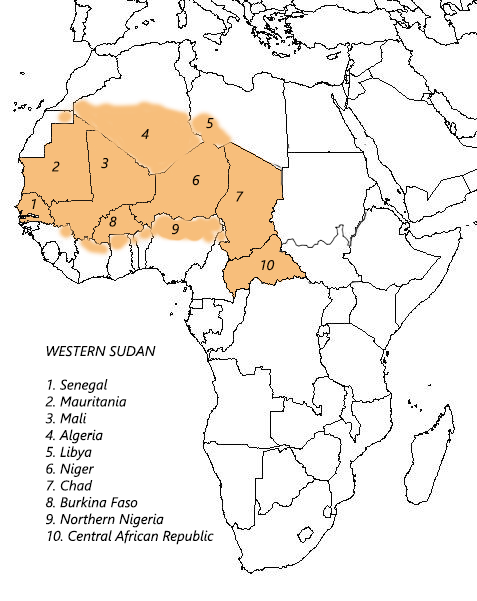
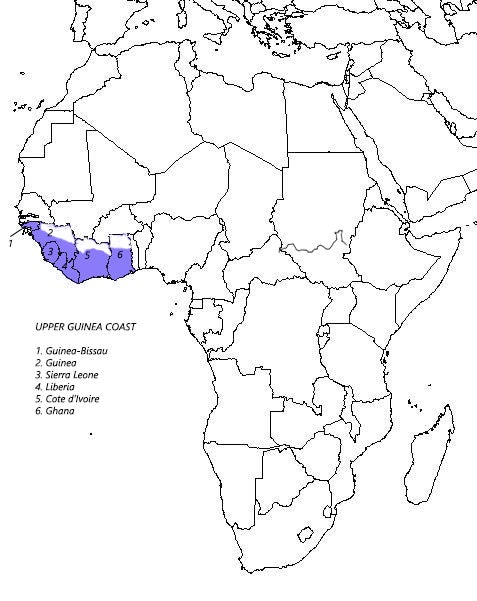
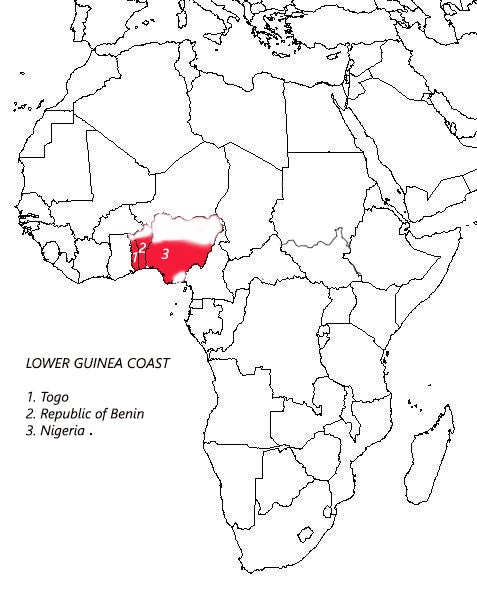
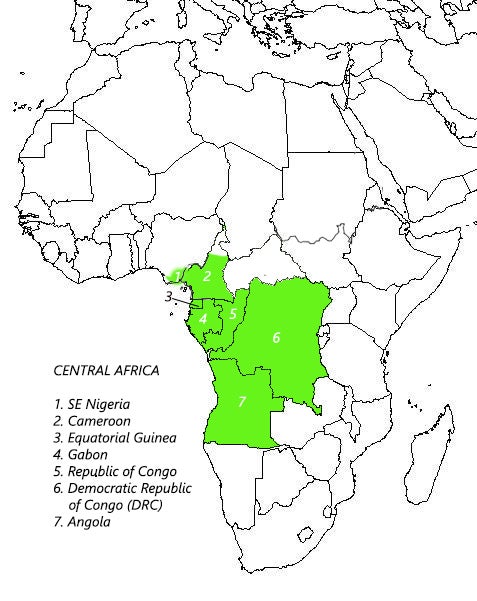
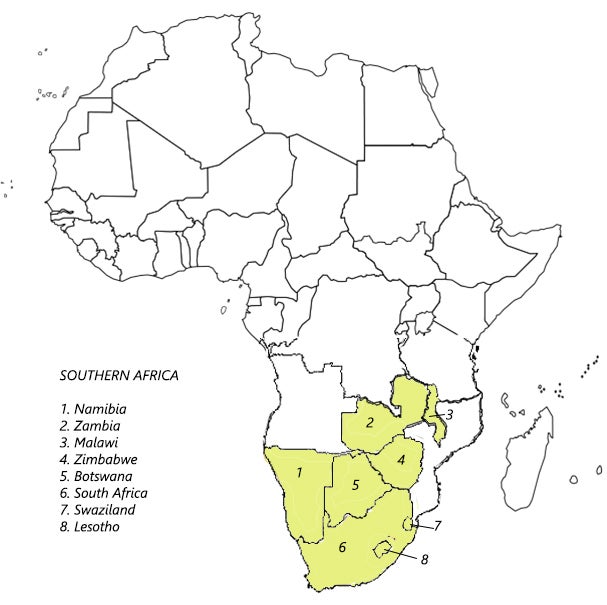
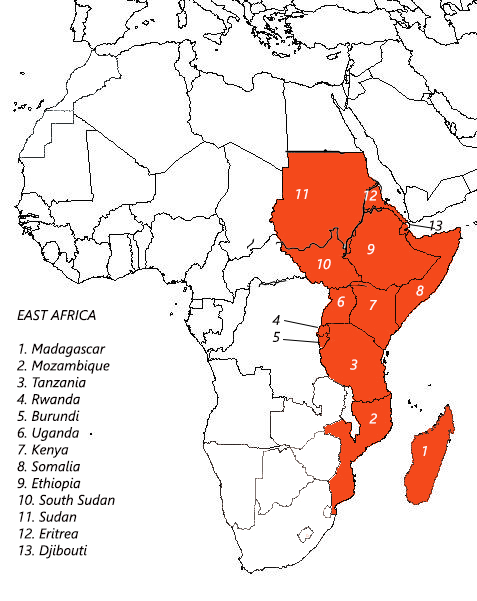
Contemporary Africa consists of 54 countries, some of which are island nations (Cape Verde Islands, Comoros, Mauritius, Seychelles, São Tomé and Principe). Nations, however, are not synonymous with cultures. Very few countries consist of a homogeneous people. Rather, countries are made up of ethnic groups; some nations are occupied by a handful, while others include over 300 (Fig. 12). These groups are only occasionally isolated. Often a given town or city includes multiple ethnic groups in large numbers; at other times, a small cluster of one ethnic group’s members live as a minority within the territory of another. Members of one ethnic group may marry members of another, but self-identification is usually dependent on the culture’s inheritance system. In a patrilineal society, where inheritance is through the male line (i.e., from father to son), a child carries the ethnicity of its father. In a matrilineal society, where inheritance is through the female line (i.e., from a man to his sister’s son), a child carries his mother’s ethnicity.
WHAT ABOUT TRIBE? While many Africans use the word “tribe” to describe their ethnicity, it is a term that carries different meanings for Americans and should be avoided because those associations are misleading. We tend to link the word tribe either with nomadic prehistoric people or with Native Americans, and in each case it has picked up connotations of small bands of people who live either on the move or reside in small villages. In the United States, we don’t use the word to discuss large populations or people who live in cities, and therefore it can distort ideas of what Africa is like, and perpetuate inaccurate preconceptions. If we don’t think of the Irish (4.8 million) or the South Koreans (51.25 million) as tribes, even though both nations have fairly homogeneous populations, why would we describe the Yoruba or the Hausa (both in the 38-40 million range) as tribes? “Ethnic group” accurately describes both the Zulu and the Han Chinese, despite differences in numbers and lifestyle.
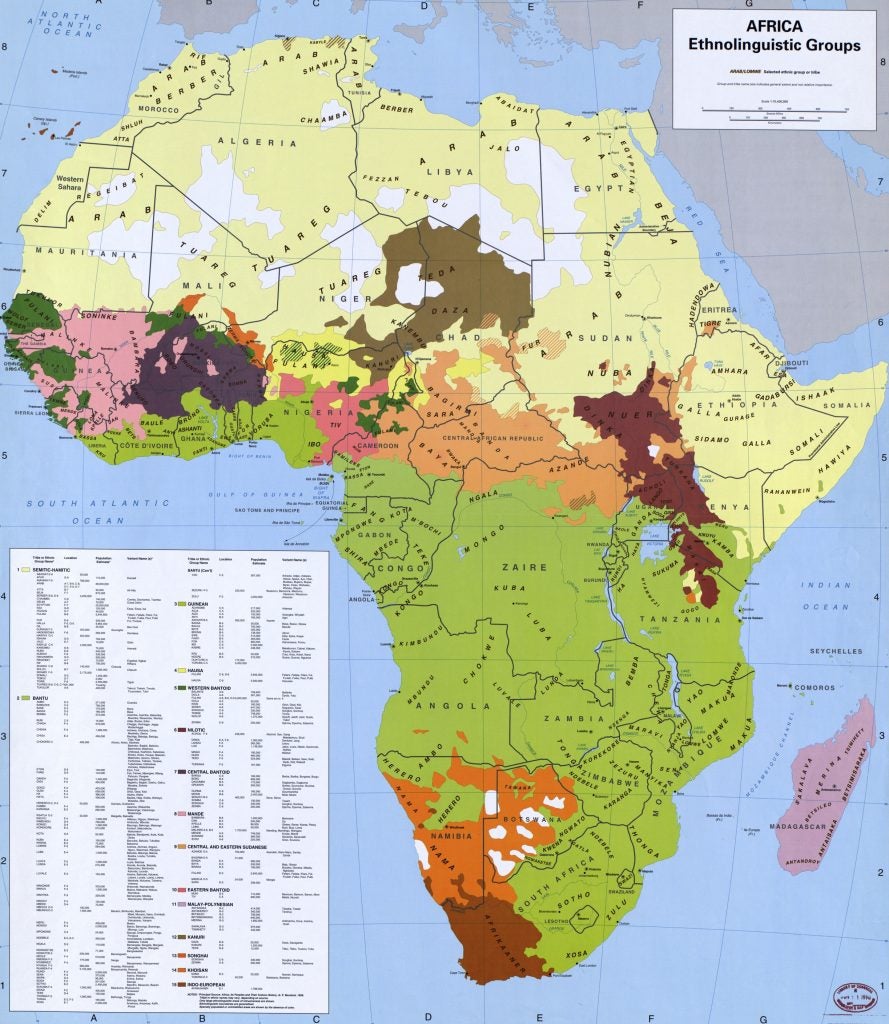
HOW MUCH HISTORY DOES AFRICAN ART HAVE?
As we’ll see, African art is full of variety. We’re going to examine art from many different parts of the continent with varied functions, appearances, and meaning.
Outside of North Africa and parts of the Sudan and Ethiopia, our knowledge of African art is severely limited historically. Most older works in museums are from the 19th and 20th century because wood has been a primary medium for sculpture. Unfortunately, both termites and acidic soil do not allow its long survival, even when objects are wrapped in insect-repellent leaves or stored in the rafters where the smoke from cooking fires helps slow insect depredations.
Art is not valued for age, but rather for vitality—a termite-ridden work will be replaced. Some mediums are more resistant—the copper-based alloys brass (copper plus zinc) and bronze (copper plus tin) will survive burial in damp soil, although oxidation may produce a greenish surface patina. Terracotta (fired clay) may break, but it will not deteriorate. Ivory will survive above ground, but it can burn in fires like wood and will deteriorate if buried.
Very little archaeological work has been conducted south of the Sahara, but when it has occurred, its style and direction often include startling deviations from what 19th and 20th-century art suggest. There are huge gaps in African art history due to these factors; the Edo people of Nigeria’s Benin Kingdom are the only ethnic group to have substantial metal and ivory works from an unbroken period of just over 500 years. This permits gauging stylistic change, the introduction of new motifs and forms, and other aspects that are commonly assessed in art worldwide. Despite the spottiness of our general knowledge of African art history, however, we do know that art on the continent began by at least 10,000 BCE (long before the Egyptian pyramids) and continues until today.
With the exception of the ancient Sahara and the impact of trade relationships across the desert, we will not be looking at the art of North Africa. While it is certainly a part of Africa, the history and art history of Egypt alone cover so many centuries that it would limit what we could examine in the rest of the continent. Likewise, a survey of this type cannot give equal attention to the arts of all parts of Africa.
Even from the relatively little we know about African art in the distant past, we can see that substantial change has occurred in over time. So what constitutes “traditional” African art, if change is consistent? Like many terms, it is imperfect, especially when contrasted with “contemporary” African art. The two words suggest division by time, but both artistic directions can coexist. “Traditional” African art is a response (whether it changes or not) to older patterns of function, such as traditional African religions, or use by traditional governmental institutions in palaces, or forms of protective and/or divinatory equipment. Traditional training is via formal or informal apprenticeship or self-education. Traditional patrons are individuals, male or female societies, priests, aristocrats or rulers.
“Contemporary” African art is distinguished by its diversions from the route of traditional art. The emphasis of its functions differs, emphasizing status display or advertising. Training can be by apprenticeship at some levels, such as sign painting, and can also result from self-education, but it often involves formalized training via a Western model: organized workshops, art school, or university specialization. Materials could be identical to those used by traditional artists, but technologies expand to incorporate acrylic or oil paint, glass, cement, resin, rubber, or other mediums that became available through foreign introduction. Contemporary patrons are usually individuals or corporate bodies—companies, hotels, government buildings—and need not be African at all. In a way, art made for export to tourists or overseas shops is contemporary art, because even if the artists are the same ones who make traditional art for local use, the shift to indirect patronage and accommodation to foreign preferences moves them toward the contemporary end of the spectrum.
In this chapter, we’ll look more carefully at both “traditional” and “contemporary” African art, examining their mediums, tools, training methods, patrons, and audiences. We’ll also examine issues of style, which apply to both types of art.

